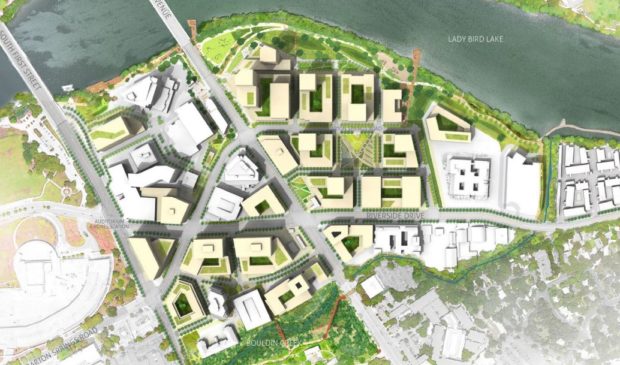South Central Waterfront’s environmental standards approved by Environmental Commission
Friday, May 25, 2018 by
Jessi Devenyns After years of planning on paper, the South Central Waterfront Regulating Plan is finally one step closer to reality after the Environmental Commission recommended the associated environmental development standards to City Council.
Along the shores of Lady Bird Lake, there is a 118-acre area of land comprising 32 private properties next to Auditorium Shores, from South First to East Bouldin Creek along the lake border. Right now, this prime piece of land leaves much to be desired, with parking lots and auto-oriented development dominating the lakeside strip and keeping pedestrians from easily accessing one of the most iconic areas in the city.
“There’s a distinct lack of infrastructure in this area,” explained Alan Holt, a principal planner with the Urban Design Division, at the May 16 meeting of the commission. “Really just 50 years ago … it was often river body. Now it is this crazy quilt of private properties.”
In order to remedy the current state of affairs, the city of Austin is proposing an expensive solution that will provide the area with green space, affordable housing and non-auto-related accessibility. That price tag, according to Holt, will be around $100 million.
To make things even more challenging, the project, which is still in the planning phase, is calling for even more stringent environmental requirements than CodeNEXT.
Environmental Officer Chuck Lesniak referred to CodeNEXT as “baseline” in comparison to the standards that this district will require. In fact, the whole design is so forward-thinking that the overall plan won a national award for sustainable development.
Many of the environmental requirements were based on the “Snoopy PUD” that is going up at 425 W. Riverside Dr.
However, not all the commissioners were impressed. Commissioner Mary Ann Neely said, “I don’t think this is anything to be proud of.” She explained that there was a “lack of innovative design” and that the green space that the design proposes is not sufficient. “When I look at that map, it’s basically all buildings,” she said in reference to the schematics being presented.
Holt countered that in comparison with the current 85 percent impervious cover in the area, even a minimal increase in green space is an improvement. Accordingly, the presented design showed an addition of a pocket park at Crocket Square with a minimum requirement of one acre and “the amount of park space by the Statesman site is nearly doubled.” The Austin American-Statesman property currently has six acres of waterfront-adjacent green space and the proposed plan will double it with the option to increase the green space up to 20 acres.
Nevertheless, Chair Linda Guerrero reminded the commissioners that they were not there to debate the merits of the overall plan; they were just to decide if the environmental requirements met their standards. As she sits on the advisory board associated with this master plan, she assured them that she would bring up the lack of green space in board discussions.
To encourage them to simply consider the feasibility and benefits of the proposed standards, not the overall design, Guerrero reminded the commissioners, “This trumps CodeNEXT, so we have to make sure … (it) is exactly what we want to happen.”
At the vote, commission unanimously recommended the environmental standards of the South Central Waterfront Regulating Plan. Commissioners Marisa Perales and Andrew Creel were absent.
South Central Waterfront Illustrative Vision Plan courtesy of the city of Austin.
The Austin Monitor’s work is made possible by donations from the community. Though our reporting covers donors from time to time, we are careful to keep business and editorial efforts separate while maintaining transparency. A complete list of donors is available here, and our code of ethics is explained here.
You're a community leader
And we’re honored you look to us for serious, in-depth news. You know a strong community needs local and dedicated watchdog reporting. We’re here for you and that won’t change. Now will you take the powerful next step and support our nonprofit news organization?






